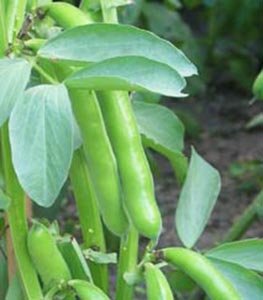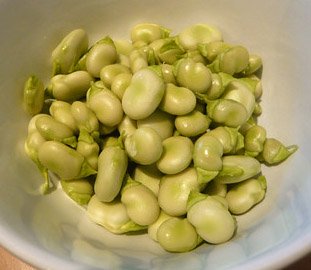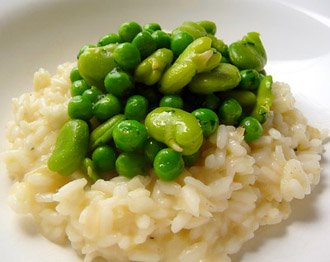Fava beans (broad beans) Nutrition facts
Fava beans (broad beans in the UK) are large, flat, light green pods usually eaten shelled for their delicious beans. Fava is one of the ancient cultivated crops that probably originated in the fertile valleys of Asia Minor or the Mediterranean region. Unlike in green beans, where whole immature pods can be eaten, broad beans possess thick indigestible peel that generally shelled to extract their broad, thick, and flat seeds (beans) inside.
Binomially, fava pods belong to the Fabaceae family, in the genus: Vicia. Scientific name: Vicia faba. Commonly used as vegetables, they are one of the popular bean varieties that can be grown easily in home gardens.
 |
| Broad bean pods. Photo courtesy: Greensteps. |
Fava bean is one of the ancient cultivated cool-season vegetables. The plant is a small annual, glabrous herb with an erect stem, growing to the height of up to 6 feet. Pink-white flowers appear in clusters after about three months after seedling. Honeybees play a role as pollinators. Light green, beaded fruit pods that develop out of these flowers, hold about 6-10, flat, broad, irregularly oval-shaped beans inside.
Health benefits of Fava beans
Broad beans are very high in protein and energy as in any other beans and lentils. 100 g of beans carry 341 calories per 100 g. Besides, they also compose plenty of health-benefiting antioxidants, vitamins, minerals, and plant sterols.
The beans are a very rich source of dietary fiber (66% per100g RDA) which acts as a bulk laxative. Dietary fiber helps to protect the colon mucosa by decreasing its exposure time to toxic substances as well as by binding to cancer-causing chemicals in the colon. Dietary fiber has also been shown to reduce blood cholesterol levels by decreasing the re-absorption of cholesterol-binding bile acids in the colon.
Broad beans are rich in phytonutrients such as isoflavone and plant sterols. Isoflavones such as genistein and daidzein have been found to protect breast cancer in laboratory animals. Phytosterols, especially ß-sitosterol, help lower cholesterol levels in the body.
Fava beans contain Levo-dopamine or L-dopa, a precursor of neurochemicals in the brain such as dopamine, epinephrine, and norepinephrine. In the brain, dopamine is associated with the smooth, coordinated functioning of body movements. Thus, the consumption of adequate amounts of fava beans in the everyday diet may help prevent Parkinson's disease and dopamine-responsive dystonia disorders. (Medical disclaimer).
Fresh fava beans are an excellent source of folates. 100 g beans provide 423 µg or 106% of folates. Folate along with vitamin B-12 is one of the essential components of DNA synthesis and cell division. Adequate folate in the diet around conception, and during pregnancy may help prevent neural tube defects in the newborn baby.
They also contain good amounts of vitamin-B6 (pyridoxine), thiamin (vitamin B-1), riboflavin and niacin. These vitamins function as coenzymes in the cellular metabolism of carbohydrates, proteins, and fat.
Besides, broad beans are one of the finest sources of minerals like iron, copper, manganese, calcium, and magnesium. At 1,062 mg or 23% of daily recommended levels, fava is one of the highest plant sources of potassium. Potassium electrolyte is an integral component of cell and body fluids. It helps counter the pressing effects of sodium on heart and blood pressure.
Young, tender, fava leaves or top greens and shoots of fava plant are also found favor in the kitchen as spring season delicacies for their incredibly nutritious values.
| Principle | Nutrient Value | Percent of RDA |
|---|---|---|
| Energy | 341 Kcal | 15% |
| Carbohydrates | 58.59 g | 45% |
| Protein | 26.12 g | 46.5% |
| Total Fat | 1.53 g | 7% |
| Cholesterol | 0 mg | 0% |
| Dietary Fiber | 25 g | 66% |
| Vitamins | ||
| Folates | 423 µg | 106% |
| Niacin | 2.832 mg | 18% |
| Pantothenic acid | 0.976 mg | 19.5% |
| Pyridoxine | 0.366 mg | 28% |
| Riboflavin | 0.333 mg | 25% |
| Thiamin | 0.555 mg | 46.25% |
| Vitamin A | 53 IU | 2% |
| Vitamin C | 1.4 mg | 2% |
| Vitamin K | 9 µg | 7.5% |
| Electrolytes | ||
| Sodium | 13 mg | 1% |
| Potassium | 1062 mg | 23% |
| Minerals | ||
| Calcium | 103 mg | 10% |
| Copper | 0.824 µg | 91% |
| Iron | 6.70 mg | 84% |
| Magnesium | 192 mg | 18% |
| Manganese | 1.626 mg | 71% |
| Phosphorus | 421 mg | 60% |
| Selenium | 8.2 µg | 15% |
| Zinc | 3.14 mg | 9% |
| Phytonutrients | ||
| Carotene-ß | 32 µg | -- |
| Carotene-α | 0 µg | -- |
| Lutein-zeaxanthin | 0 µg | -- |
Selection and storage
As in green peas, fava too are winter season crops. They can be easily grown in the home garden. Kernels of tender, green pods are preferred as vegetables over fully mature and dry pods. Dry pods, however, may be used as dry beans or split lentils. Small, very immature pods can be eaten with skin much like green-beans. Usually, however, the pods are shelled, and their seeds are employed in cooking.
In the markets, fresh fava beans can be available from March until June. Canned, frozen, dry, as well as salted and roasted beans are also available in the stores.
While buying, look for fresh, just mature, even shaped, green color beans. Avoid yellow pods as they may indicate overmature, dry, and bitter seeds.
Once at home, place unshelled beans in a perforated plastic bag and store in the refrigerator set at high relative humidity. They stay well for up to a week or so. Use them soon after harvest in order to enjoy their rich natural flavor.
Preparation and serving methods
Fresh broad beans are easy to cook and truly delicious. Gently cooked, tender beans have a wonderful “beany” flavor that melts like butter in the mouth. Dried beans are generally soaked in water to turn them soft and to remove any bitter anti-nutritional compounds.
 |
| Shelled broad beans. Photo courtesy: wordridden |
To prepare, wash the beans in cold running water. Refrigerated beans need to be dipped briefly in room-temperature water to help them regain their original flavor.
To shell, snap its stem end towards the string side and pull all along the length of the bean to remove the string. Split open and extract the kernels with the help of fingertips and thumb. Drop them into boiling salted water for about 1 minute. Drain water and plunge them into ice water.
Normally, whole broad beans are employed in cooking. You may also remove the husk (thin coat around the bean) to pop out bright green cotyledons (kernels) inside, which are then used in the cooking.
Here are some serving tips:
 |
| Broad beans and peas risotto. Photo courtesy: Blue moon |
Broad beans are one of the versatile vegetables. They make delicious recipes in stews, soups, and stir-fries along with spices, herbs, rice, semolina, peas, carrot, onion, tomato, lamb, poultry, and seafood.
In North African and Middle Eastern cuisine, boiled couscous (semolina) is served with broad beans and other vegetable stew.
Ful medames, an Egyptian mashed fava bean stew topped with parsley, is served with bread for breakfast.
Spicy broad bean stews (dip) served with bread, b>beyssara, is a favorite Moroccan breakfast.
Dried fava beans lentils used in stew with tomato, onion, and spices is a popular Greek recipe.
Safety profile
Favism is a genetic condition affecting a small population with G-6PD (Glucose-6-phosphate dehydrogenase) enzyme deficiency, compromising oxygen-carrying capacity in their blood. The condition is triggered in these individuals by eating fava beans or its products in the diet as well as by some drugs and infections. Prevention mainly includes avoidance of any of these triggering factors and treatment of acute blood cell lysis.
Like other class beans and some Brassica group vegetables, fava too contains oxalic acid, a naturally occurring substance found in some vegetables, which, may crystallize as oxalate stones in the urinary tract in some people.
Therefore, people with known oxalate urinary tract stones are advised against eating vegetables belonging to the Brassica and Fabaceae family. Adequate intake of water is therefore encouraged to maintain normal urine output to minimize the stone risk. (Medical disclaimer).
Also read ≻≻-
≻≻-Adzuki beans nutrition facts and health benefits.
≻≻-Lima beans nutrition facts and health benefits.
≻≻-Back to Vegetables from Fava beans. Visit here for an impressive list of vegetables with complete illustrations of their nutrition facts and health benefits.
≻≻-Back to Home page.
Further reading:
Stanford School of Medicine Cancer information Page- Nutrition to Reduce Cancer Risk.